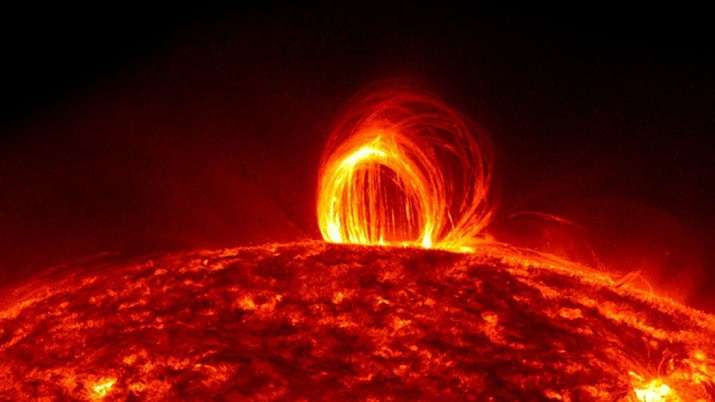
In this paper, we present 1.56 μm vector magnetograms with the highest cadence and resolution ever obtained, which are much less subject to line profile changes, yet reveal a sudden increase of the azimuth angle. Thus, the magnetic anomaly/transient is not intrinsic to the Sun, but an artifact in magnetic measurements due to the change of line profile. The authors drew similar conclusions that the polarity reversal is a consequence of the line profile change. From space-based observations, magnetic anomalies were reported during an X 5.6 flare observed by the Michelson Doppler Imager on-board Solar and Heliospheric Observatory (MDI/SOHO) 21 and an X 2.2 flare observed by the Helioseismic and Magnetic Imager on-board Solar Dynamics Observatory (HMI/SDO) 22. The plausible explanation is that the profile of the Fe I line at 5324 Å, used for the magnetic measurements, turned from absorption to emission due to the flare heating at lower layers of solar atmosphere 19. An example is the magnetic anomaly or magnetic transient, a temporal reversal of magnetic polarities measured simultaneously with flare emission, first reported by 19, 20 using BBSO data. Transient changes were rarely observed in the literature.

In contrast to the stepwise temporal profile in permanent changes, the characteristic profile of a transient change is more like a δ function in time. Using the data with higher spatiotemporal resolution obtained by the 1.6 m Goode Solar Telescope (GST, formerly known as the New Solar Telescope 16) at Big Bear Solar Observatory (BBSO 17), the sudden rotation is found to be nonuniform and synchronous with the flare ribbon propagation 18. On the other hand, rapid rotations associated with X-class flares were reported 5, 14 and attributed to the torque introduced by the change of horizontal Lorentz force 15. Bodily rotation is one of the intrinsic properties of sunspots or sunspot groups first observed by Evershed (1910) 13, which are usually gradual and continue during the entire lifetime. As a consequence, sudden intensity changes of magnetic features (usually the penumbra) are observed 1, 10, 11, 12. Direct measurements of vector fields have shown that horizontal fields increase near the PIL and decrease in the nearby penumbral regions during flares 6, 8, 9. During flares, the reconnection rearranges the topology of magnetic loops and the tilt changes consequently. Tilt angle, also known as inclination angle, is determined by the ratio between vertical and horizontal magnetic components.
Mflare from sun free#
More importantly, shear flow can drop significantly after the flare 3, 5, 8, indicating that a certain amount of magnetic free energy has been released. Previous observations show the spatial correlation between strong shear flow and flare emission 2, 7.

Shear flows measure horizontal motions of magnetic features along both sides of the magnetic polarity inversion line (PIL). Permanent magnetic changes are irreversible phenomena of photospheric fields in reaction to the flare impacts, usually during strong flares greater than M-class.

Most of them are permanent changes, while transient changes are rarely reported, and are suspected of being instrumental artifacts. In addition to the radiation, significant changes of the magnetic fields have been observed in the literature 1, 2, 3, 4, 5, 6. However, many manifestations are visible in the lower solar atmospheres, i.e., the chromosphere and photosphere.

It is well accepted that many solar flares, and other violent eruptions such as coronal mass ejections (CMEs), result from magnetic reconnection occurring in the corona.


 0 kommentar(er)
0 kommentar(er)
